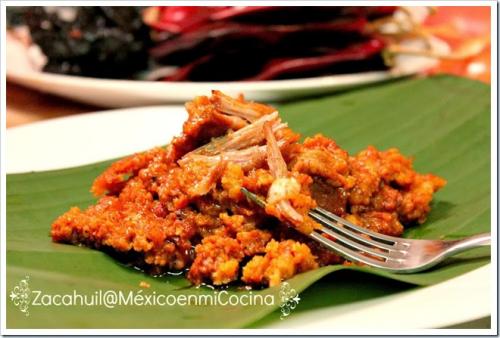
La historia del zacahuil
La historia del zacahuil
Verónica Martínez Venancio y Alfredo Lara Álvarez

An biyal t´ilab k´al an zacahuil
K´al an ok´talab ti 1431, Tenochtitlán, Texcoco y Tacuba in abatna´ an bichowchik tének ani tam k´al an tamub 1458, Moctezuma in ko´oy abatnadhchik an caudillo, noble, cacique ani an ténekchik, abal ka nedhajchik ti "Tlamalín Xochitl", juni k´wajtalab juni u ko´oyab an wik´axte´ tenek, po ok´ox, lej ti odhnaj k´al an aztecas "Cihuacóatl Tlacaelel", kom kotniyatchik ti uxum, majuyat jant´idja jats ani t´ajchin ka bixomats ti Cuextlán, ani jayej antsana´ u bijiyab an bixomtalab a Moctezuma ani xowé´k´ij i exlal ti danza de los comanches.
Ti 1468 an bichowchik tujey ki in jalbiy juni i "calpixqui" juni abatwalej a Moctezuma in bijil "Quimichtín" o t´él, kom jant´oy in t´ajal, an ténekchik in bijiychik "Huehutli", a xi le´ ki in uluw "at´ax yejtsel " (pil jun jita´ in ulal abal in le´ ki in ulw " biyal bél".
Tam ti ulits a "Huehutli" tujey an tsemdhanél k´al an tsákamchik xi ít wa´tsinal, axé´, jats abal ka juts´unchat in xits´al, kom abal jajá´ jats abal ka k´wajiy kwitóley, ani jayej in odhnalchik an uxumchik, ma yab in t´ajal jawa´ jats in tamub in kwa´al; jats antsana´ ti in ela´ an k´wiyaxte´ k´al an Ténekchik, in tejwamedha´ in pojkaxtal , junkunchik ani ibits in le´na´ ki in jalbiy jant´oj k´al an aztecas abal talbél ki in kwajba in ba´ k´al jajáchik, ok´lomtechik k´al jun kwitólej a xi u bijiyab "Iztacoyotl" (dhakchuh) atatal a "Shinguiri" (biyal xumpalel), y por "Chilhuaqui" (waynek its) rey ti Xicóac y "Tepoxmoyulis" (pecho duro).
Po tamin ats´achik abal an aztecas atanchik k´al an tarascos, k´alejchik ki in aliy a Huehutli abal ki in ko´oy yek´wadh, tsemdhachi, t´ak´chin in nuk´, ani punchik i keladh k´oyej , its ani tsé´edh k´al an tsa´, dhu´badh k´al i dhulup.
Jats antsana´, in patal in t´u´úl jats ok´ox ts´ejka ti huastecapan, jun i "tlaixpictle" (dhákcham) o "chacahuil"- zacahuil (Tének), ts´ejkaj jun pulik i jól ti an tsabál, junti t´uchiyat ti t´újub ani i k´alul jats tu puktsiyat, ani tam ti tek´eyits, buk´wat abal an uxumchik xi odnaj, jats abal ki ko´oy t´okat in ba´ ani tam ti k´wajatits in k´apuwalchik, in ulal dhajnalchik "tlanque cualantli" (taleyits ).
Axé´ an t´ajbilab t´ajaniyat k´al an pextalab, antsana´ jilk´on ti exdha t´ajnél; an kwiynelchik yek´wanchik abal ka ko´oyat ani ka ts´ejka ti zacahuil abal ka k´apuwat, po tam ti ulitschik an an lab inikchik , axé´ in ucha´chik abal lej ti alwa´ ki in ts´ejka´chik ti t´ulek ti palats o ti olom, ma ti xowe´ jat kwajateyej u ts´ejkab, ani antsana u t´ajnale k´al an biyal t´ajbilab.
En el reinado de 1431, Tenochtitlán, Texcoco y Tacuba dominaron los pueblos de la huasteca y para el año de 1458, Moctezuma hizo prisioneros a los caudillos, nobles, caciques y reyes huastecos para llevarlos a "Tlamalín Xochitl", un lugar donde tenían la prisión huasteca, pero antes, fueron humillados por los aztecas "Cihuacóatl Tlacaelel", vistiéndolos de mujer, pintándolos a su manera tradicional y obligándolos a bailar en Cuextlán, que es llamada así a la danza de Moctezuma y que hoy en día la conocemos como la danza de los comanches.
En 1468 los pueblos comenzaron a pagar tributo a un "calpixqui" (mayordomo) de Moctezuma llamado, "Quimichtín" o ratón, al que por sus acciones, los huastecos bautizaron con el nombre de "Huehutli" (huehue-viejo, tlicutli-brasas), cuya interpretación es la de "viejito caliente o libidinoso", (otros dicen que significa "camino viejo").
Con la llegada de "huehutli" se comenzó el sacrificio de niños recién nacidos, esto, para chuparles la sangre, acción que según él, funcionaba para recuperar la juventud, además de que cometía abusos sexuales con mujeres, sin importar la edad; de esta manera, fue ganándose el repudio de los huastecos, quienes mostraron su coraje, se revelaron y se negaron a seguir pagando tributos a los aztecas para después levantarse contra ellos, liderados por un joven guerrero al que llamaban "Iztacoyotl" (coyote blanco) hermano de "Shinguiri" (gorro o sombrero viejo), y por "Chilhuaqui" (Chile seco) rey de Xicóac y "Tepoxmoyulis" (pecho duro).
Pero cuando se enteraron que los aztecas fueron derrotados por los tarascos, fueron en busca de Huehutli para tomarlo de prisionero, lo mataron, lo degollaron, y lo envolvieron de masa martajada, enchilada y molida en un metate, cubriéndolo con hojas de plátano.
Fue de esta manera, que con todo su cuerpo prepararon por primera vez en Huastecapan, un "tlaixpictle" (náhuatl) o "chacahuil"- zacahuil (Tének-huasteco), hicieron un enorme hoyo en la tierra, el cual llenaron de piedras ardientes y brasas, lo cubrieron, y una vez cocido, se repartió entre todas la mujeres ultrajadas, esto, para limpiar su honra y mientras lo comían, gritaban jubilosas "tlanque cualantli" (se acabó el problema).
Esta práctica se popularizó entre las guerras, transformándose en una tradición; a los enemigos los tomaban como prisioneros y hacían el zacahuil para comérselos, pero con la llegada de los españoles, éstos les aconsejaron que era mejor hacerlo con la carne del guajolote o del puerco, siendo adquirido este cambio hasta nuestros días, continuando con dicha tradición.
The origin of zacahuil
Back in the history of México, before Spanish conquest, during the kingdom of native people by the year of 1431, there were three groups, Tenochtitlán, Texcoco and Tacuba, which used to dominate the small towns of the Huasteca culture and by the year of 1458, the legendary leader Moctezuma, made them prisoners, altogether the warlords, the nobles, overlords and Huastecos kings, so they were taken to the "Tlamalín Xóchitl", a place designated as a Huasteca prison, but before this, they were humiliated by the Aztec people named "Cihuacóatl Tlacaelel", who force them to wear traditional women indumenta, using their traditional colors body paints on their bodies and make them dance at "Cuextlán", name used for the dance of Moctezuma, and also known as the dance of "los comanches" nowadays.
In 1468, the conquered people started to pay tribute to a Moctezuma´s "calpixqui" (administrator) which name on native language was "Quimichtín" (mouse), which, because of his actions, was nicknamed as "Huehutli" (Huehue-old and Tlicutli-hot coal), so the interpretation was "dirty old man or libidinous" (referred by others as "old path").
Within the arrival of "Huehutli", newborn babies´ sacrifices started, so he could suck them out their blood, practice that according to him, it would work to recover youth, besides, he committed several sexual abuse women, no matter their age; because of this, the Huastecos people repudiated him and to show their anger, hey rebelled by not paying tribute to the Aztec people and planned to raise against them, led by a young warrior named "Iztacoyotl" (white coyote), and he was brother of "Shinguiri" (toque or old hat) and also on their side was leading "Chilhuaqui" (dried chili), who was the king of Xicóac, within the company of "Tepoxmoyulis" (strong chest).
When Huastecos people realized that the Tarascos warriors had defeated to the Aztec people before they fight them, they stand back and were in the searching of Huehutli to take him as a prisoner, but they killed him, beheaded, and smeared him with a traditional mass (corn mass mixed with hot chili smashed on a special stone called "metate") and finally they covered him with banana plant leaves.
This way, they prepared within his body as a first time what we know as a "Tlaixpictle" (Náhuatl language) or a "Chacahuil" - "Zacahuil" (Tének or Huasteco language) at the place known as Huastecapan; they made a hole on the ground and then they filled it with hot stones and coals, they introduced the dead body in and covered, once "cooked", they divided into pieces and fed the outraged women by him with the meat, doing this, to clean up their honor and as they ate the body they would scream jubilantly "tlanque cualantli" (the problem has ended).
This same practice was popularized among other wars, becoming into a tradition; they would take their enemies as prisoners and after that, they would prepare the "Zacahuil" to eat them, but with the arriving of the Spanish people to the continent, they were advised to substitute with "Guajolote" (turkey) and pork meat, the human bodies, change that was acquired until present day, as a tradition of the Huasteca culture.
email. veromtzv00@gmail.com
Foto ilustrativa propiedad de http://www.mexicoenmicocina.com/2013/10/como-hacer-zacahuil-en-casa.html
emsavalles© 2006 - 2025 Todos los derechos reservados. Queda prohibida la publicación, retransmisión, edición y cualquier otro uso de los contenidos sin previa autorización.
Emsavalles Publicidad, Escontría, 216-A, Zona Centro, Ciudad Valles, S.L.P. Tel:481-382-33-27 y 481-381-72-86. emsavalles@hotmail.com. contabilidad@emsavalles.com
No. de Certificado de Reserva Otorgado por el Instituto Nacional del Derecho de Autor: 04-2021-071615041800-203


